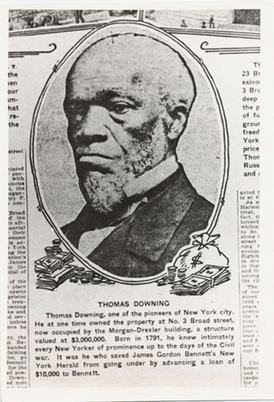Downing's Oyster House
Before New York was called the Big Apple, it could have been called the Big Oyster. New York was famous for its oysters. And Thomas Downing, a free black man, owned the most famous oyster house of all. Bankers, politicians, stockbrokers, lawyers, businessmen, and socialites flocked to Downing’s Oyster House to eat raw, fried, or stewed oysters, oyster pie, fish with oyster sauce, or poached turkey stuffed with oysters. As the crowd of power brokers ate and made deals under the chandeliers, Thomas’s son George lead escaping slaves to the basement. There they were safe from the “blackbirders,” or bounty hunters, who were roaming the streets in search of runaways.
From 1825 to 1860, Thomas, and his son George T. Downing were part of the Underground Railroad to Canada and freedom. They were also leaders in the growing abolitionist movement. In 1836, Thomas helped found the all-black United Anti-Slavery Society of the City of New York. The next year he began petitioning New York State for equal suffrage for black men. He took one petition after another to Albany. "If one petition failed, another would be presented," he said. When not a single high school in the city would accept African American students, he helped found the first schools that would accept them. According to his son, Thomas Downing was an "extremely active" man who "knew not tire."
When Thomas Downing died on April 10, 1866, the New York Chamber of Commerce closed for the day out of respect.
This entry contributed by
Curriculum Concepts International
Related Media
Images

|
Downing’s Oyster House was located at 5 Broad Street, but his basements, where fresh oysters were stored and escaping slaves were hidden, included numbers 3, 5, and 7 Broad Street.
|

|
Thomas Downing rowed out to the boats to pick over the oysters before the ships reached the oyster barges along the East River. Downing’s Oyster House served only the best.
|
